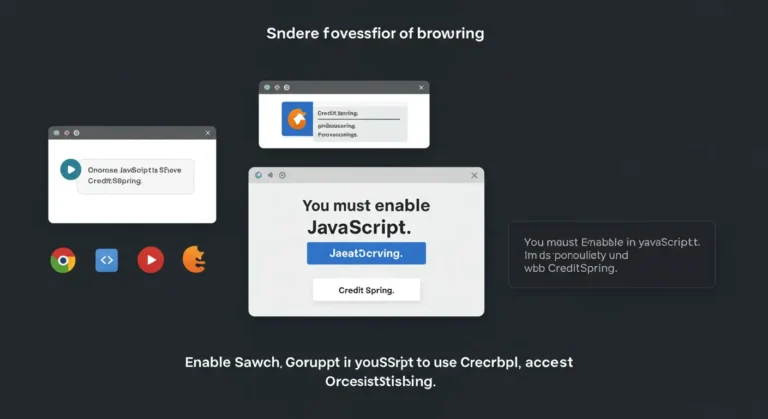Introduction
If you’re trying to access CreditSpring, but keep encountering a message that says, “You must enable JavaScript in your browser to use CreditSpring”, you’re not alone. This issue is fairly common, and it’s usually a quick fix. In this article, we’ll explain why enabling JavaScript is important for using CreditSpring and guide you through the steps to resolve this issue in various web browsers.
What is CreditSpring?
CreditSpring is a financial service platform designed to help individuals improve their credit score by offering credit-building products and tools. The platform allows users to access loans and financial services that can assist in their credit improvement journey. However, to ensure that all features and functionalities work correctly, CreditSpring requires JavaScript to be enabled in your browser. Without JavaScript, some of its interactive features may not function as intended.
Why You Must Enable JavaScript to Use CreditSpring
JavaScript is a programming language that enables interactive elements and dynamic content on websites. When you visit a site like CreditSpring, JavaScript is used to load and manage the platform’s features, such as account login, personalized recommendations, and real-time updates. Without JavaScript enabled, these interactive elements might not work, resulting in issues like the “You must enable JavaScript in your browser to use CreditSpring” message.
By enabling JavaScript, you’re allowing the website to fully load and function, giving you access to all the features and tools that CreditSpring offers. JavaScript plays a crucial role in modern web design, which is why many sites, including CreditSpring, require it to work smoothly.
How to Enable JavaScript in Your Browser
Now that you know why JavaScript is necessary for using CreditSpring, let’s walk you through the process of enabling it in different browsers. Follow the steps for the browser you’re using.
Enabling JavaScript in Google Chrome
- Open Google Chrome and click on the three vertical dots in the top right corner to open the menu.
- Select Settings.
- Scroll down and click on Privacy and Security.
- Under Site Settings, scroll down to the Content section and click on JavaScript.
- Toggle the option to Allowed (recommended).
- Refresh the CreditSpring page.
Enabling JavaScript in Mozilla Firefox
- Open Mozilla Firefox and click on the three horizontal lines in the top-right corner.
- Select Preferences or Options.
- Scroll down and click on Privacy & Security.
- Under the Permissions section, look for the JavaScript option (usually under Content Blocking).
- Check the box next to Enable JavaScript.
- Refresh the CreditSpring page.
Enabling JavaScript in Microsoft Edge
- Open Microsoft Edge and click on the three dots in the top right corner.
- Select Settings.
- Scroll down and click on Cookies and Site Permissions.
- Under Site Settings, click on JavaScript.
- Toggle the switch to Allowed.
- Refresh the CreditSpring page.
Enabling JavaScript in Safari
- Open Safari and click on Safari in the menu bar at the top of your screen.
- Select Preferences.
- Click on the Security tab.
- Check the box next to Enable JavaScript.
- Close the window and refresh the CreditSpring page.
Common Issues When Enabling JavaScript
While enabling JavaScript is a simple process, there may be some issues you encounter along the way. Here are a few common ones:
- Browser Cache Issues: Sometimes, old data stored in your browser cache can cause problems. Clear your browser cache and try re-enabling JavaScript.
- Extensions Blocking JavaScript: Certain browser extensions, like ad blockers, can interfere with JavaScript. Try disabling extensions temporarily to see if that resolves the issue.
- Outdated Browser Version: Ensure that your browser is up-to-date. Older versions may have compatibility issues with modern JavaScript requirements.
- Security Settings: If you’re using a public network or have a strict firewall, your security settings may block JavaScript. Check your firewall settings or try using a different network.
Conclusion
Enabling JavaScript in your browser is essential to use CreditSpring effectively. By following the simple steps outlined in this guide, you can quickly resolve the “You must enable JavaScript in your browser to use CreditSpring” issue. Once JavaScript is enabled, you’ll have access to all the tools and features that CreditSpring has to offer, helping you manage and improve your credit with ease.
Read More : Why Is Temu So Cheap Compared to Amazon? A Complete Comparison
Frequently Asked Questions (FAQs)
- Why does CreditSpring require JavaScript?
CreditSpring relies on JavaScript to load interactive features and dynamic content, which is necessary for a smooth user experience. - What happens if I don’t enable JavaScript?
If JavaScript is disabled, some features of CreditSpring may not work properly, preventing you from accessing your account or using the site effectively. - How do I know if JavaScript is enabled in my browser?
You can check the browser settings as outlined in this guide. If the option is set to Allowed or Enabled, JavaScript is active. - Can I use CreditSpring on a mobile browser?
Yes, CreditSpring is mobile-compatible, and JavaScript is typically enabled by default on mobile browsers. However, ensure that your mobile browser is up-to-date. - Is there a way to enable JavaScript for specific websites only?
Yes, most modern browsers allow you to enable JavaScript globally or for specific websites. You can adjust the settings in your browser’s Content Settings or Site Settings.


1 Comment
Pingback: OutlookMail365: 10 Powerful Tips for Mastering Email Management